Did you know that bathrooms rank among the most moisture-prone spaces in your home? This makes them perfect breeding grounds for mold and water damage.
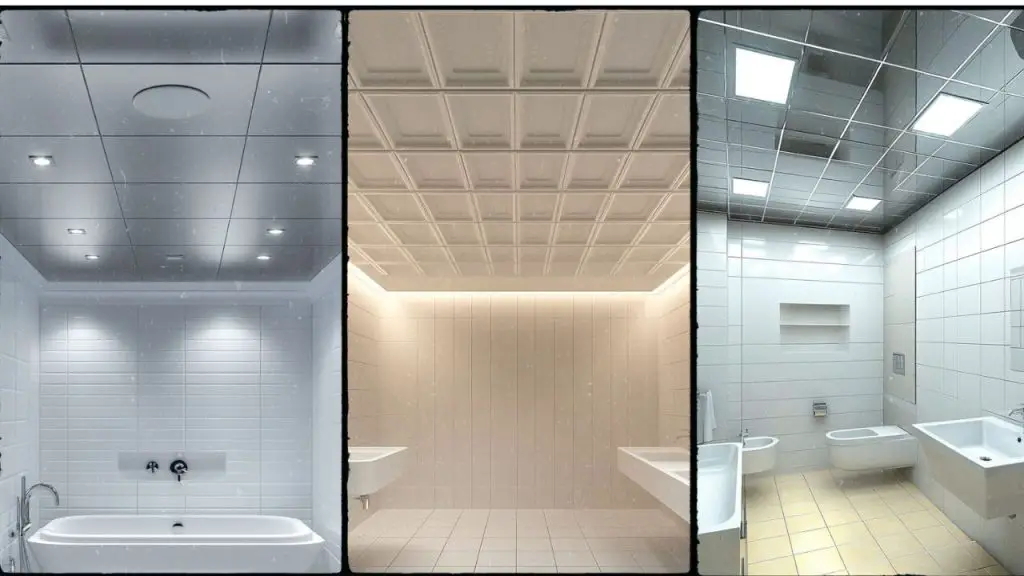
The right bathroom ceiling material is a vital part of your home’s longevity and your family’s well-being. Traditional ceiling materials don’t work well in high-moisture environments. Modern options like greenboard, fiberglass panels, and aluminum composite panels give you better water resistance and durability.
Your bathroom renovation or new construction project needs the right ceiling material choices. Each option brings unique benefits from moisture-resistant gypsum boards to light-reflecting acrylic panels that add beauty to your space.
Suitable Materials For Bathroom
This piece walks you through the best materials for bathroom ceilings. You’ll learn what works best based on your needs, budget, and style priorities. Let’s help you create a bathroom ceiling that looks great and stands the test of time.
Understand What Your Bathroom Needs
You should review your bathroom’s specific conditions before picking the perfect ceiling material. Your bathroom creates unique challenges that will affect which materials work best in your space.
Check moisture and ventilation levels
The bathroom is without doubt a moisture battleground. Water vapor from every shower, bath, and hand-washing settles on surfaces when airflow isn’t adequate. Persistent moisture creates perfect conditions for mold to grow, especially when bathrooms lack natural light.
Take a look at your bathroom’s moisture profile by asking:
- Do surfaces show regular condensation?
- Can you spot moisture problems like stains, corrosion, or peeling paint?
- How well does your current ventilation system work?
Ventilation Assessment Table:
| Ventilation Feature | Optimal Condition | Why It Matters |
| Exhaust fan | Properly sized (1.1 CFM per square foot minimum) | Removes moisture before it damages ceiling materials |
| Duct system | Vents directly outside, not into attics | Prevents moisture buildup in hidden areas |
| Fan noise level | 1.5 sones or less | Ensures comfort without disruption |
Note that waterproof ceiling materials can’t handle long-term moisture exposure. Installing a quick-working exhaust fan becomes essential whatever ceiling material you pick.
Think about ceiling height and lighting setup
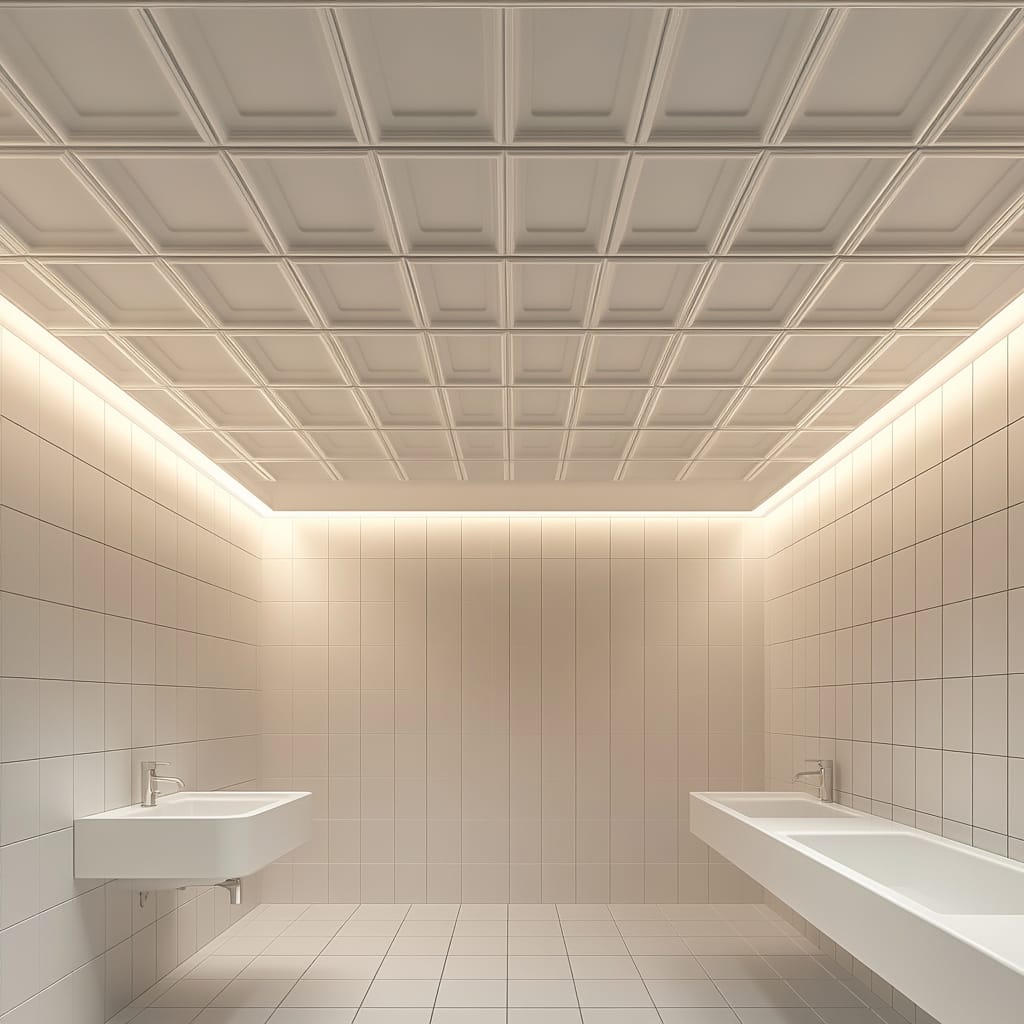
Your bathroom’s ceiling height substantially affects material selection. Building codes suggest an 8-foot minimum ceiling height in bathrooms. Some standards allow heights as low as 6’10.5″ in areas where people normally stand.
Your lighting setup also plays a crucial role with ceiling materials:
- Safety requirements: Bathroom lights must resist moisture and meet electrical codes. Wet-rated fixtures belong near tubs or showers, while damp-rated ones work in less exposed spots.
- Material reflectivity: Each ceiling material reflects light in its own way. Acrylic sheets come in options from transparent to solid, which changes how light spreads through your bathroom.
- Integration options: Today’s ceiling materials work well with different light setups, including recessed lights and built-in ventilation fans.
The right ceiling height, proper ventilation, and suitable lighting are the foundations for picking the best bathroom ceiling material. Understanding these basic needs helps you avoid materials that might fail early because of your bathroom’s unique conditions.
Compare the Most Common Bathroom Ceiling Materials
The right bathroom ceiling material can make a huge difference. Let’s look at your options to help you pick something that’s durable, easy to maintain, and fits your budget.
Drywall vs. Greenboard vs. Cement Board
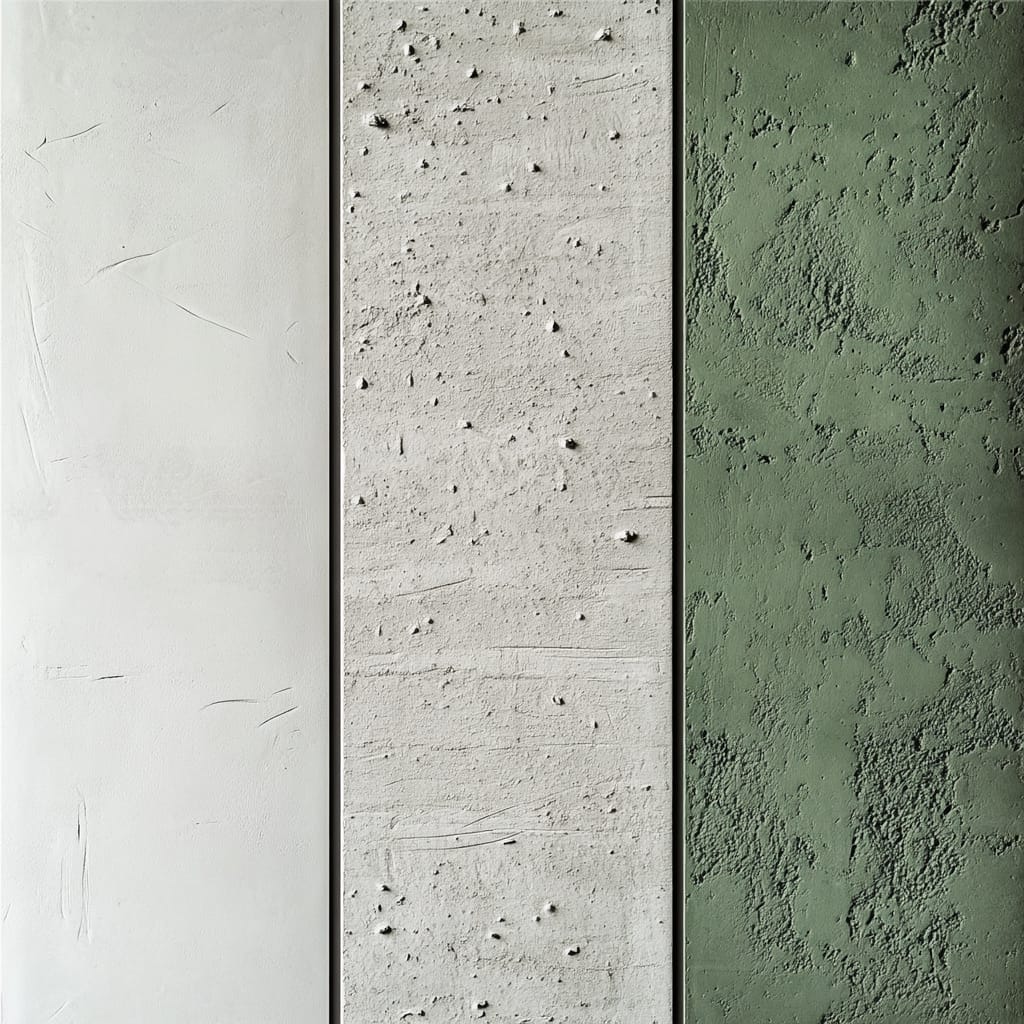
Regular drywall shows up in most homes, but it doesn’t work well in bathrooms because moisture can damage it. Greenboard gives you better protection with its water-resistant green covering. You’ll pay about 20% more than standard drywall, but its wax coating handles bathroom conditions better. Still, it’s not completely waterproof.
Cement board stands up best to direct water contact. Its reinforced concrete and glass fiber mesh construction won’t break down with water exposure. This material works great for shower areas, but you’ll need vapor barriers during installation to get the best results.
Material Comparison Table:
| Material | Water Resistance | Cost | Installation Difficulty |
| Regular Drywall | Poor | Lowest Easy | Easy |
| Greenboard | Moderate | Medium | Easy |
| Cement Board | Excellent | Highest | Moderate |
Fiberglass and Acrylic Panels
Fiberglass reinforced plastic (FRP) panels give you outstanding moisture resistance and durability. These panels resist moisture completely, won’t shatter, handle temperature changes well, and clean up easily with steam or soap. Acrylic panels look modern and sleek. They fight off mold growth, which makes them perfect for shower ceilings.
Aluminum Composite Panels (ACP)
ACPs combine two aluminum sheets with a polyethylene core to create strong but lightweight panels. These panels work well and look great. They insulate against sound and heat. The panels resist fire, need little upkeep, and come in many colors and finishes to match any bathroom style.
PVC and Plastic Paneling
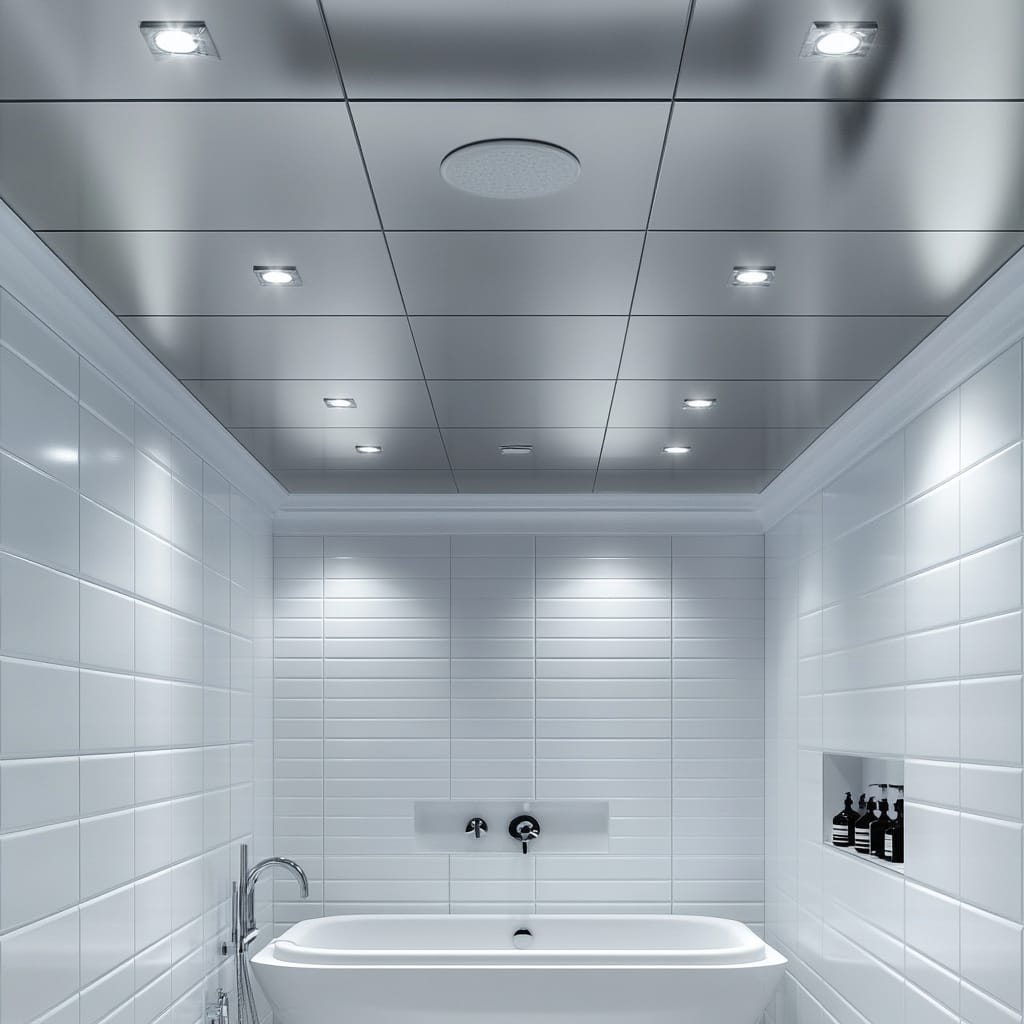
PVC panels excel as waterproof options for bathroom ceilings. Unlike drywall, these panels don’t soak up moisture, which protects them from water damage in humid spaces. Installation goes four times faster than drywall, and they weigh 40% less. You won’t need to mud, tape, or paint them. DIY renovators love these panels because they only need soap and water to stay clean.
Match Materials to Your Budget and Style
The perfect bathroom ceiling material depends on functionality and what fits your budget. Your available funds will shape which options work best for your project.
Low-cost options for small bathrooms
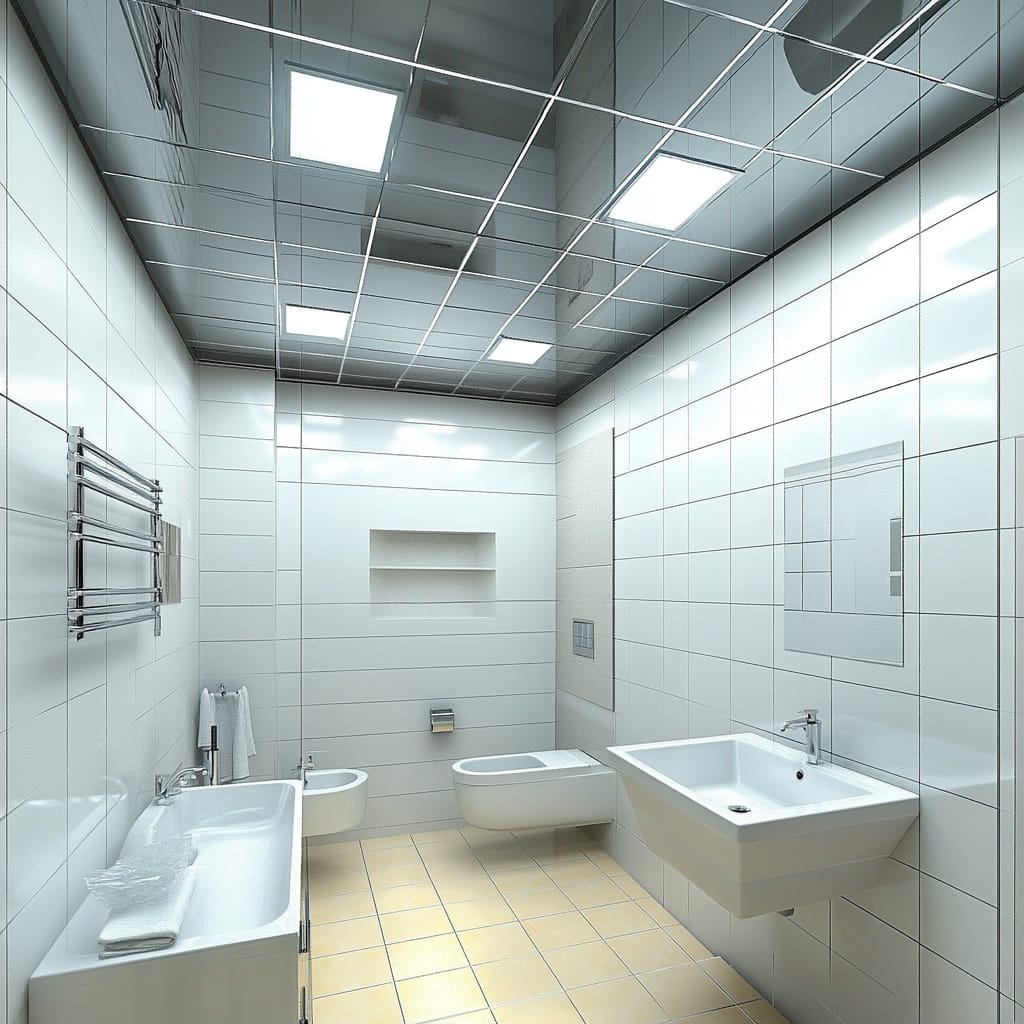
Several affordable materials deliver good performance when you’re working with a tight budget:
Paint: A budget-friendly choice that works best with semi-gloss or satin finishes to resist moisture. Light colors can make your space feel taller and more open.
Drywall/Greenboard: Regular drywall installation costs USD 2.00 to USD 4.00 per square foot. Moisture-resistant greenboard runs about 20% higher than standard drywall but guards better against humidity.
PVC Panels: These waterproof panels cost more upfront but save you from painting and handle moisture better. Waterproof PVC peel-and-stick ceiling tiles are easy to work with and don’t need special tools or skills.
Mid-range picks for modern upgrades
People with moderate budgets can get better durability and style with these options:
Fiberglass Panels: These panels hit a sweet spot between price and durability. They resist water well, install easily, and won’t sag or show damage as they age.
Acrylic Sheets: From transparent to solid colors, these plastic sheets blend function with style. They add a modern touch that fits well in today’s bathrooms.
Drop Ceilings: Installation costs run USD 4.00 to USD 20.00 per square foot. These systems make it easy to reach plumbing and come with water-resistant options.
Premium materials for luxury bathrooms
Luxury finishes can take your bathroom to the next level:
Specialty Tiles: Porcelain and glass mosaic tiles can turn your ceiling into a stunning feature. Your choices range from patterned porcelain to eye-catching glass pebble mosaics.
Aluminum Composite Panels: These top-tier panels excel at moisture resistance and strength. They block sound well and come in several high-end finishes.
Custom Wood Treatments: White shiplap or sealed wooden planks add warmth and fight moisture. This approach brings sophistication to your bathroom’s “fifth wall”.
Material Cost Comparison:
| Material Type | Price Range (per sq ft) | Best For |
| Paint | USD 1.00-2.00 | Budget renovations |
| Greenboard | USD 2.00-4.00 | Moisture protection |
| Fiberglass | USD 4.00-7.00 | Durability/value |
| Premium Tiles | USD 10.00-30.00+ | Luxury esthetics |
Installation and Maintenance Considerations
Your choice of bathroom ceiling material affects both time and money when it comes to installation and upkeep. These practical aspects help determine if a material suits your project.
Ease of installation for DIYers
Different DIY-friendly options vary by a lot in how complex they are to install. Waterproof PVC peel-and-stick ceiling tiles are the easiest option and need no special tools or DIY skills. Fiberglass is also popular for bathroom renovations because it offers mess-free installation without technical expertise.
The weight of cement board makes it challenging and usually needs professional installation. Drywall and greenboard sit in the middle range of difficulty.
Installation Difficulty by Material:
| Material | Difficulty | Special Tools Needed | Professional Help Recommended |
| PVC Tiles | Very Low | No | No |
| Fiberglass | Low | Yes | No |
| Drywall/Greenboard | Medium | Yes | Optional |
| Cement Board | High | Yes | Yes |
Cleaning and upkeep over time
Regular cleaning stops mold spores from settling and growing. PVC ceiling panels need just a simple wipe-down with soapy water to stay clean. Fiberglass panels resist moisture and staining, which makes them great for low-maintenance needs.
Mild detergents mixed with water work well for cleaning all bathroom ceiling materials. Adding white vinegar helps in areas prone to mold. Mold-resistant cleaning solutions help keep your ceiling’s look and structure intact.
Lifespan and replacement frequency
Material quality, installation, and maintenance affect how long your ceiling lasts. Materials like PVC panels and fiberglass last longer than painted surfaces and need less upkeep.
Fiberglass provides reliable, lasting performance with fewer repairs and replacement costs. Moisture-resistant drywall costs 30-50% more than standard drywall upfront but you only need it in moisture-prone areas like bathrooms.
Life expectancy numbers should guide you, as actual longevity depends on use, weather, installation quality, and maintenance. Good ventilation remains the quickest way to make any bathroom ceiling material last longer by keeping excess moisture away.
Conclusion
Your bathroom ceiling material choice plays a crucial role in your home’s long-term health. You’ll find the perfect mix of durability and style by looking at moisture levels, ventilation requirements, and what fits your budget.
Quick Decision Guide:
| Your Priority | Recommended Material | Why Choose This |
| Budget-friendly | PVC panels | Easy installation, waterproof |
| Maximum durability | Cement board | Superior moisture resistance |
| Modern esthetics | Aluminum composite | Sleek finish, low maintenance |
| DIY installation | Fiberglass panels | Simple setup, reliable protection |
Note that good ventilation matters whatever ceiling material you pick. Quality ceiling materials combined with proper airflow will create a moisture-resistant bathroom that stands the test of time.
Getting a full picture of your space needs should kick off your bathroom ceiling project. Think about moisture levels, how much light you need, and how complex the installation might be before you decide. Smart planning now will give a bathroom ceiling that looks great and works well for years.
FAQs
Q1. What is the best material for a bathroom ceiling? The best material depends on your specific needs, but moisture-resistant options like greenboard, fiberglass panels, and PVC panels are popular choices. These materials offer superior water resistance and durability in high-humidity environments.
Q2. How important is ventilation for a bathroom ceiling? Ventilation is crucial for any bathroom ceiling. Proper airflow helps prevent moisture buildup, which can lead to mold growth and material deterioration. Installing an efficient exhaust fan is essential, regardless of the ceiling material chosen.
Q3. Can I install a bathroom ceiling myself? Some materials, like PVC peel-and-stick tiles and fiberglass panels, are DIY-friendly. However, others like cement board may require professional installation. The ease of installation varies depending on the material and your skill level.
Q4. How do I maintain my bathroom ceiling? Regular cleaning with mild detergents and water is usually sufficient for most bathroom ceiling materials. For mold-prone areas, adding white vinegar to the cleaning solution can help. PVC and fiberglass panels are particularly easy to maintain with simple wipe-downs.
Q5. What’s a good budget-friendly option for a bathroom ceiling? For those on a budget, moisture-resistant paint or PVC panels are cost-effective choices. While greenboard costs slightly more than regular drywall, it offers better humidity protection at a reasonable price point.
